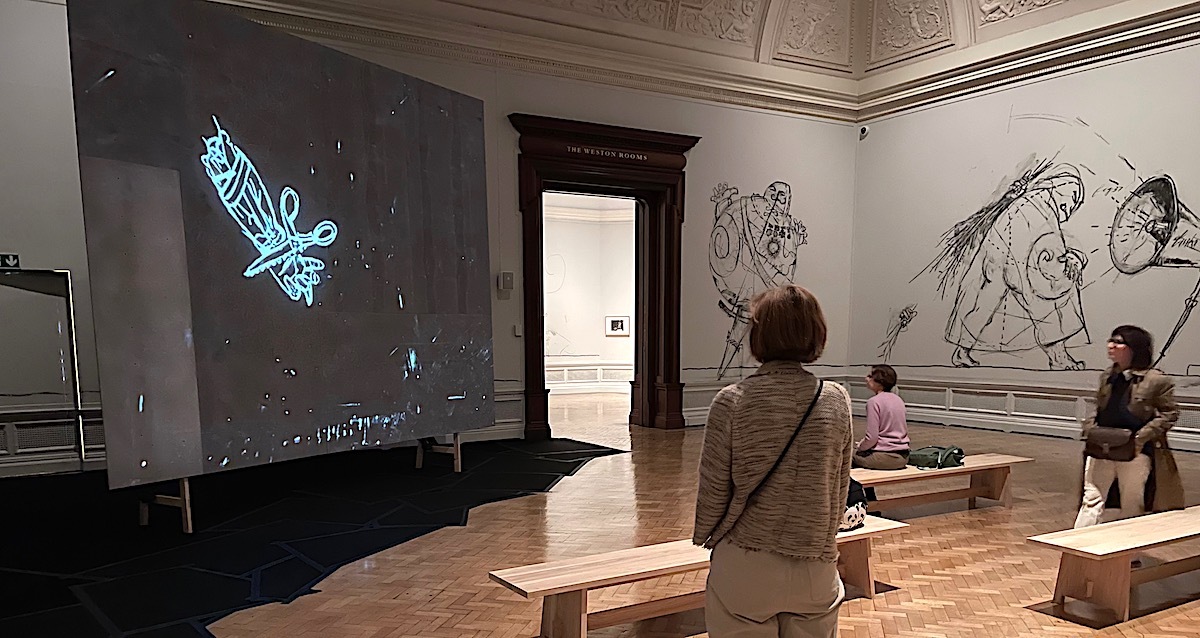Ubu Roi was first performed on December 10th, 1896, at what is now the Théâtre de Paris on the Rue Blanche. A stylised burlesque by the French playwright Alfred Jarry, it satirised power, greed, bourgeois complacency, along with the institutional abuse of power. The scatological language, the apparently childish writing and production in which Jarry insisted that King Ubu wear a cardboard crown on his head like a character from a mummer’s play caused a riotous response. Something of a cause célèbre, it opened the door to Dadaism, Surrealism and the theatre of the absurd. A parody of Macbeth (with a smattering of Hamlet and a soupçon of King Lear thrown in for good measure), its single performance was lambasted by those who saw it, with the exception of W.B. Yeats and the poet and essayist Catulle Mendès, who considered it to be a ground-breaking work. Since its inception, successive generations have reinvented Ubu Roi to suit their own ends.
Ubu Tells the Truth is among Kentridge’s most impassioned and violent works
The white south African artist William Kentridge has used the play to express his views against South African apartheid and its vicious attacks on its black citizens. Born in 1955 to liberal Jewish parents, lawyers who represented those marginalised by the system, Kentridge grew up in a highly politicised household. Despite a precocious artistic talent, he studied Politics and African studies at Witwatersrand university before embarking on a diploma in Fine Arts and studying mime and theatre at the famous L’ École de Théâtre Jacques Lecoq in Paris. Originally he wanted to be an actor and between 1975 and 1991 acted and directed with Johannesburg’s Junction Avenue Theatre. These diverse creative strands, along with a comprehensive knowledge of film and opera, have contributed to a singular body of work that incorporates elements of theatre, cinema and drawing to create hard-hitting social and political commentary that steps into areas where few white artists have dared to go.
In 1994 Nelson Mandela was elected President of South Africa after his long Robin Island incarceration. The following year, the Truth and Reconciliation Commission was set up under the auspices of Archbishop Desmon Tutu to address the wounds inflicted by apartheid. In 1997 Jane Taylor, a long-time collaborator with Kentridge, wrote Ubu and The Truth Commission, a theatrical piece which was developed with the Handspring Puppet Company and directed by Kentridge.
Ubu Tells the Truth is among Kentridge’s most impassioned and violent works, which highlights the shenanigans of a ridiculous but devastating despot. As with Jarry’s original play, power is revealed and undercut through the use of the absurd. Built from a palimpsest of etchings and charcoal drawings, clips were created by the constant erasure of an image and then adding further layers of charcoal. These were then mixed together with archival footage and animations from the original stage production. The film has been exhibited on its own, or as in the show at the RA, with accompanying wall drawings.
A grotesque, cartoon-like man, corpulent and over-fed, sporting a curled moustache, struts across the screen full of menace and self-importance. The sketchy black and white animations endlessly transmute. A drawing of an eye blinks, then transforms into a real staring eye, evoking the notorious razor scene in Buñuel’s Un Chien Andalou. Later it metamorphosises into a camera fixed to a tripod (to become the eye of surveillance?), scuttling across the screen like Kafka’s cockroach in Metamorphosis. Human skulls and bones, scissors, and a hack saw (the instruments of torture) all tumble down a shower plughole, along with human skulls and bones and a seemingly, innocent bird to disappear in what might be seen as an act of washing away guilt and evidence. The head of a pig appears out of a cloud wearing earphones, and a curvaceous female body dances before evolving into a scissor-wielding skeleton. A dance of death, or a nod to the pornography of violence, perhaps? It is difficult to know, for there is no exact translation of Kentridge’s imagery. Nothing is spelt out. The images simply pile one upon the other in an orchestrated symphony of implied violence to create dreamlike associations.
There are fat men in striped suits and black bodies that fall from skyscraper windows or have their heads rammed into buckets in empty rooms before being lassoed by the feet and left to swing like Billie Holiday’s Strange Fruit from trees. Drawings of broken bodies and pools of blood flash past. Interspersed with these are short archival film clips of the South African police violently attacking black unarmed apartheid protestors with whips, charging into a running crowd in Cato Manor in 1960 or storming a group of students at Wits University in 1985, along with footage from the 1976 Soweto uprising. All the while, the balletic camera/tripod/eye scuttles past on its thin mechanical legs, watching, recording, and noting.
Ubu Tells the Truth makes for uncomfortable viewing with its absurd, jerky, brutal juxtapositions of sound, cartoon-like drawings and photographic material. As in all of Kentridge’s work, the viewer is never let off the hook. There is no place to hide. No ideological position, no didacticism or moral lesson is offered. Instead, he lifts a Swiftian mirror to show that this is what humans are capable of doing, one to another when power becomes absolute. The political artist has become a rare beast in our postmodern world, but Kentridge has shown with passionate commitment that it can still have teeth.
William Kentridge, Royal Academy of Arts, 24 September – 11 December 2022
Sue Hubbard is a freelance art critic, novelist and poet. Her novel Rainsongs is published by Duckworth and her latest poetry collection, Swimming to Albania, is available from www.salmonpoetry.com. Her fourth novel, Flatlands is due from Pushkin Press in 2023 as is her new series of poems on the life of Gwen John, God’s Little Artist, from Seren Poetry.

